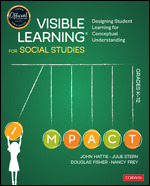Visible Learning for Social Studies, Grades K-12
Designing Student Learning for Conceptual Understanding
- John Hattie - The University of Melbourne, Australia
- Julie Stern
- Douglas Fisher - San Diego State University, USA
- Nancy Frey - San Diego State University, USA
Corwin Teaching Essentials
Read this review from the National Social Studies Supervisors Association, Spring 2021:
https://us.corwin.com/sites/default/files/vlss_from_nsssa_the_leader_spring_2021.03_002_0.pdf
Help students move from surface-level learning to the transfer of understanding.
How do social studies teachers maximize instruction to ensure students are prepared for an informed civic life? VISIBLE LEARNING® for Social Studies, Grades K-12 shows how the field is more than simply memorizing dates and facts—it encapsulates the skillful ability to conduct investigations, analyze sources, place events in historical context, and synthesize divergent points of view.
The Visible Learning framework demonstrates that learning is not an event, but rather a process in which students move from surface-level learning to deep learning, and then onto the transfer of concepts, skills, and strategies. Encouraging learners to explore different facets of society, history, geography, and more, best practices for applying visible learning to social studies curriculum are presented through:
· A scaffolded approach, including surface-level learning, deep learning, and transfer of learning
· Examples of strategies, lessons, and activities best suited for each level of learning
· Planning tools, rubrics, and templates to guide instruction
Teachers must understand the impact they have on students and select approaches to maximize that impact. This book will guide you through the process of identifying the right strategy for the right time to successfully move students through surface, deep, and transfer learning.
Free resources
Webinar: Visible Learning for Social Studies
How do we maximize precious time to ensure that students grasp enough to prepare them for informed civic life? The discipline of social studies is far more than memorizing dates and facts. It involves the skillful ability to conduct investigations, analyze sources, place events in historical and cultural context, and synthesize various points of view, while recognizing our own biases. Join Julie Stern in this webinar to understand how using the right approach at the right time can maximize student learning.
Examples of Surface, Deep, and Transfer Strategies in Geography
This excerpt includes examples of surface, deep, and transfer strategies for geography in Visible Learning for Social Studies.
Feedback Strategies
This excerpt from Visible Learning for Social Studies covers feedback strategies to use in the classroom.
Laying the Groundwork for Visible Learning
In this free excerpt, the authors lay the groundwork for visible learning in social studies.
Sample Materials & Chapters
Hattie Visible Learning for Social Studies, Grades K-12_Look Inside Content.pdf
